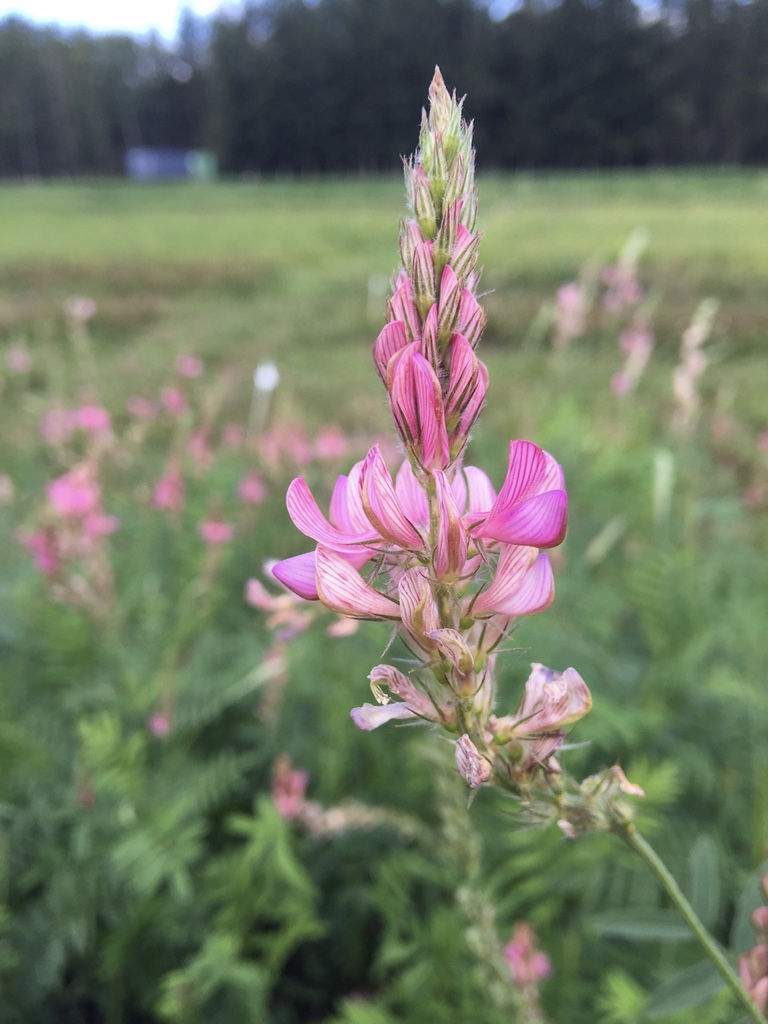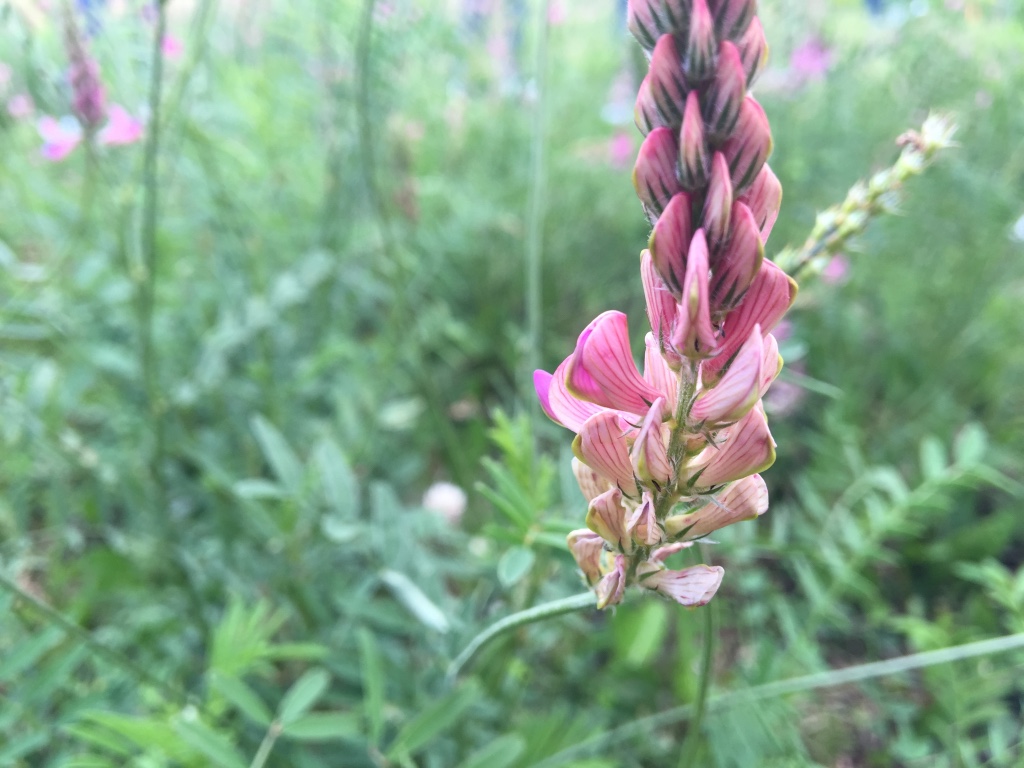Sainfoin (Onobrychis vicilifolia) is a pretty cool legume. Pretty, too.
It’s not native to North America. Rather, it is an Eurasian native. It came to North America for a reason: high-quality fodder for livestock.
You can’t mistake the bright pink blooms in the summertime: the kind of blooms that make a person’s head turn and mutter, “What is that?”
The first blooms start at the very bottom of the spike. As those lower ones finish blooming, the following “row” begins to get ready to open up. In other words, sainfoin blooms from the bottom up.
The dead flowers continue maturing, turning into seeds. One single seed is enclosed in a veiny-looking seed pod.
Some plants are so vigorous that two or more rows bloom simultaneously. Whenever I’ve encountered sainfoin at its prime blooming stage, the middle flowers always seem to be at their brightest, most glorious blooms.
Did I mention that they’re pink? Yes, indeed! They look striking, with darker pink lines running laterally down and along the banner and less so along the keel. Not many flowers look like sainfoin, certainly none native to Western Canada nor as a pasture forage species.
These plants also grow straight and tall. They don’t creep along the ground, have tendrils stretching out looking for other plants to support their weight, or grow such long, complex branches of leaves and stems that they form big clumps. No, standing between two to four feet tall, their alternate leaves branch out from this single stem, soaking in the sun’s rays.
Sainfoin is a legume, meaning, like alfalfa, it produces very high-quality feed and fixes nitrogen. It’s not the plant itself that fixes nitrogen, but rather the rhizobacteria that infect the roots, creating bright pink to blood-red nodules, who are most responsible for that job.
But, unlike alfalfa, sainfoin produces condensed tannins which are phyto compounds that slow nitrogen digestion by rumen microbes and prevents bloat. Sainfoin stands right along with other legumes like cicer milkvetch, and birdsfoot trefoil for being hailed as a bloat-free “hero” of the legume forage family.
Sainfoin grows best in well-drained soils that also retain some moisture. It doesn’t like getting its feet too wet, and it doesn’t mind the long periods of drought either.

But that’s not the story I want to tell.
The story I’d like to tell involves how it went from an unpopular, weak, though beautiful cousin to alfalfa to something that can now be grown right beside the Forage Queen, unphased.
The old sainfoin varieties (such as Elmi, Remont, Nova, and Melrose) were (and still are) recommended in a monoculture stand. Their ability to compete with other forage species was poor and, at best, undesirable. Agrologists recommend that these old varieties be mixed with non-creeping grasses like Russian Wild Rye so that they have a chance to maintain their populations in the stand. But, with any other species that could spread quickly by rhizomes, avoiding such a mixture is recommended if possible.
In a word, the old sainfoin varieties couldn’t hold a candle to alfalfa. They didn’t grow back as quickly as alfalfa after grazing and couldn’t stay as long as they should. Thus, trying to seed sainfoin with alfalfa for the purpose of preventing bloat just wasn’t feasible. It was a right shame.
That said, I’ve seen clumps of naturalized sainfoin growing in the ditches of southern Alberta. I’ve no clue about which variety they hail from. I suspect those “escapee” plants evolved and adapted from those older generations. Mostly, those wild plants grew in different clumps, not evenly spaced as if they would be manually seeded in the field or pasture. However, it speaks to their strength and ability to adapt where it’s not expected. (Also, unlike in pastures or hay fields, these plants can set seed in those ditches. I’ll talk about why this is important later.)
Thus, the research trials experimenting with seeding these old varieties in different mixtures were disappointing.
It’s a shame because sainfoin is an excellent legume for grazing. It doesn’t cause bloat; the tannins prevent bloating in ruminants and control internal parasites. Win, win.
Deer love sainfoin. Most farmers haven’t been able to explain why, but I suspect those deer are eating sainfoin because it tastes really good and helps them battle internal parasites. Again, win-win!
Well, for the deer, anyway.
Wild deer can’t receive deworming medication like livestock, so they must find ways to self-medicate. According to research from Dr. Fred Provenza, these deer possibly use the knowledge passed down from their mothers to seek certain plants that help quench nutritional cravings or even self-medicate most ailments.
It sounds crazy, but wait until you read about Dr. Fred Provenza’s studies on this subject matter. It’s amazing. (Believe it or not, even domestic animals have this same aptitude, despite claims and other studies that claim otherwise.)
Canadian forage researcher scientists also thought it was a shame that sainfoin had such potential but couldn’t hold its own in a pasture stand. So, in c. 2010, they put their heads together to find a way to improve those old varieties to prevent bloat and increase sainfoin’s competitive edge in pasture.
THIS PAPER describes the findings of creating new sainfoin varieties to be more competitive with alfalfa and orchardgrass. (Source: Poudel & Archarya. 2022. Compatibility of new sainfoin populations as forage mixtures with alfalfa and orchardgrass in Alberta. Canadian Journal of Plant Science, Vol. 102, No. 6. https://cdnsciencepub.com/doi/10.1139/cjps-2022-0148)
THIS PAPER discusses how sainfoin performed when in a mixture and grazed by a group of steers. (Source: Sottie, et. al. 2017. Performance of alfalfa-sainfoin mixed pastures and grazing steers in western Canada. The Professional Animal Scientist, vol. 33, issue 4. https://www.sciencedirect.com/science/article/pii/S1080744617300967)
Finally, THIS PAPER describes the challenges and rewards of breeding sainfoin to be more competitive so that it could be used in pastures to prevent bloat. (Source: Poudel et. al. 2023. An insight into sainfoin (Onobrychis viciifolia Scop.) breeding: Challenges and achievements. Agronomy Journal, vol. 115, issue 6. https://acsess.onlinelibrary.wiley.com/doi/10.1002/agj2.2143)
I don’t like using the word “competitive” because plants in an ecosystem operate more collaboratively than competently. Perhaps, to think of this a little differently, the old sainfoin varieties that “couldn’t compete” couldn’t collaborate as effectively as these new varieties developed by the team of Canadian forage breeders. The ecology the old sainfoin varieties were exposed to was unfavourable for their success as a species. So, it needed specific attributes and traits that the Poulin and others (from the Agriculture Canada Lethbridge Research Station in Lethbridge, Alberta, Canada) could develop to survive better in a diverse pasture stand.
I’m getting sidetracked, but it’s worth thinking about.
The next step in the breeding process was to test how this new variety performed under natural conditions. Of course, one needs to harvest enough seed to make this happen and get some relatively uniform animals in age, sex, breed, and size to test their efficacy in the stand. (Let’s be honest: the uniformity of the animals used in the trial isn’t as important as the type of forages used in the seeded pasture stand. However, uniformity is essential for the consistency of creating a study so that certain variables can be fixed so as not to skew the data!)
I was fortunate to hear first-hand about the grazing trial researchers like Dr. Surya Archarya carried out in 2016. One paper, published in 2013 (see THIS LINK), described how that went down. But, the way he told it in his presentation was a bit less dry and more entertaining than in the research paper.
He had 10 beef Angus steers for this grazing trial. They were grazed in plots containing different mixtures of AC Blue J, an old and popular alfalfa variety, the old and popular Nova sainfoin variety, and the new sainfoin varieties not-then named. He did not mention grasses, as they were not part of the trial.
The steers were closely monitored for bloat. With such a higher percentage of alfalfa than sainfoin, bloat potential was a big factor in the study.
The funny thing was, as Dr. Archarya told it, nobody bloated except one steer when grazing Blue J plus the new sainfoin variety. This same steer happened to be a chronic bloater, so every time they took data on the cattle in the pasture, this same steer was the one causing the issues… and caused a slight skew in the data!
By that, I mean that if they hadn’t had that one chronic bloating steer, instead of 98 percent bloat reduction, they would’ve had 100 percent! But, alas.
Thus, in 2015, the new sainfoin variety AC Mountainview was released. It was promoted quite heavily to producers all over Alberta (and Saskatchewan) as part of a “high-legume pasture project” initiative partnership between Agriculture Canada and the Alberta provincial government.
Two years later, AC Glenview, the second sainfoin variety, was released. Both it and Mountainview have since been made available for purchase to farmers to seed in their hayfields and pastures.
It’s a bit of a success story, I suppose. Currently, I don’t have any data on how sainfoin has increased in popularity, but I think it’s safe to assume that, thanks to the Lethbridge forage research team and agriculture extension efforts here in western Canada, it’s slowly gaining popularity.

Some More Agronomy Information
Sainfoin can be seeded so that it has about 25% of the biomass compared with alfalfa to prevent bloat. It can be seeded at higher rates with alfalfa and other grasses like orchardgrass, meadow brome, timothy, and more.
There are many more seeds per pound with alfalfa (around 200,000) compared to sainfoin (around 2,000 to 5,000). Therefore, when calculating seeding rates, the amount of alfalfa to seed versus sainfoin should be much lower to get the 50-50 or 75-25 alfalfa-sainfoin mix!
Seeding depths for sainfoin and alfalfa are no different from each other. A well-packed seedbed is crucial for good establishment as with any forage stand. Seed-to-soil contact is vital, even if you’re considering sod seeding. Use something like a Brillion seeder rather than broadcast seeding if rejuvenating an old hay or pasture stand.
Inoculation is necessary for sainfoin as with alfalfa. However, research has shown that inoculants commercially available for alfalfa aren’t suitable for sainfoin. More research needs to be done to get the right inoculants available for sainfoin.
Established sainfoin must be allowed to set seed once every couple of years. This allows sainfoin to persist longer in the stand.
Sainfoin must be grazed so it has plenty of leaf material left behind to regrow. It doesn’t do well with heavy grazing. Rotational grazing is considered the ideal means of grazing sainfoin to get adequate rest once the animals leave.
Some research has found that the old varieties can be as productive as the new varieties in terms of suitability for grazing and productivity under the right management practices. However, the ability for plants to set seed is still vital, regardless of the variety you choose.
For more information on sainfoin, I highly recommend THIS PUBLICATION by Agriculture and Agri-Food Canada called Sainfoin in Western Canada for more information.
Have any comments, questions, or concerns? Feel free to drop me a line or leave a comment below!